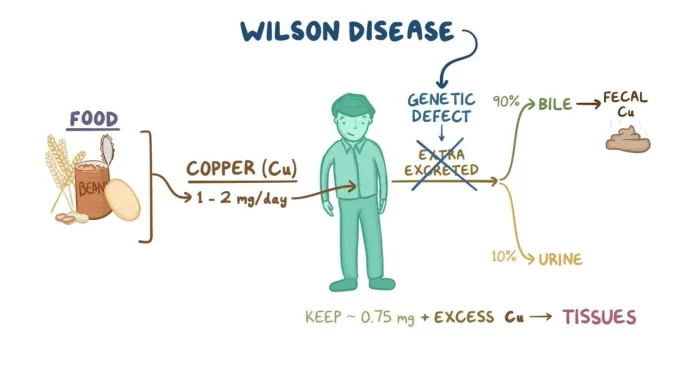Wilson’s disease is a rare inherited disorder that causes excessive copper accumulation in various organs, particularly the liver, brain, and eyes. This buildup of copper can lead to severe health problems if left untreated.
Symptoms:
The symptoms of Wilson’s disease can vary widely and may include:
- Fatigue
- Jaundice (yellowing of the skin and eyes)
- Abdominal pain and swelling
- Easy bruising
- Neurological symptoms such as tremors, difficulty speaking, and involuntary movements
- Behavioral changes
- Kayser-Fleischer rings (copper deposits in the eyes)
Causes:
- Wilson’s disease is caused by mutations in the ATP7B gene, which is inherited in an autosomal recessive pattern.
- Both parents must carry a copy of the mutated gene for a child to inherit the disorder. If both parents are carriers, there’s a 25% chance with each pregnancy that the child will inherit Wilson’s disease.
- However, not everyone with a mutation in the ATP7B gene will develop Wilson’s disease. Some carriers may never show symptoms.
Treatment:
- The primary goal of treatment is to reduce copper levels in the body and prevent further accumulation.
- Treatment typically involves medications that bind to copper and help eliminate it from the body. Common medications include penicillamine, trientine, and zinc acetate.
- In severe cases or when medications are ineffective, liver transplantation may be necessary to remove the damaged liver and replace it with a healthy one.
- Regular monitoring of copper levels and liver function is crucial for managing the disease and adjusting treatment as needed.
Prevention:
- Since it is a genetic disorder, there’s no way to prevent it entirely.
- Genetic counseling can help individuals understand their risk of passing the disease on to their children and make informed decisions about family planning.
- Early detection and treatment are essential for managing Wilson’s disease and preventing complications.

































